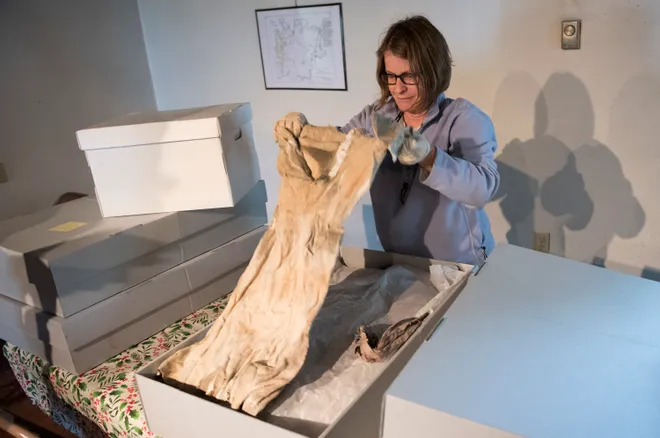More than 40,000 Americans are genetically related to 27 enslaved people excavated from Maryland
Recent genetic testing conducted on the remains of enslaved people recovered from a Maryland metal workshop about 40 years ago may help piece together the family history of more than 41,000 Americans.
Scientists compared the DNA from the 27 individuals, 16 of which were men and 11 women, ranging from infants to adults over the age of 60, to about 9.3 million research participants that utilized 23andMe’s genetic testing services.
The group’s familial ties, their ancestry, location of relatives and what their genetic makeup said about their health were some of the topics investigated over the course of the study, according to an excerpt published on Science.org.
The study found that 41,799 of American participants were related to the 27 individuals with about 2,975 close relatives.
Enslaved individuals operated the iron furnace and were tasked with both domestic and agricultural duties during the late 18th and early 19th century, according to the study.
Relatively little is known about the African Americans who worked at Catoctin Furnace despite the role it played in suppling ammunition during the Revolutionary War.

The cemetery where the bodies of the workers were buried was in use from 1774 to 1850, but the remains weren’t excavated until the 1970s due to highway construction in the area, Reuters reported. They are now being held at the Smithsonian.
"The experiences of African Americans within the early industrial complex of the United States are not completely understood and their labors in this system have not been thoroughly explored or acknowledged. We hope this paper gives voice to these 27 individuals while it acknowledges their origins and centers their histories within the broader context of the United States," Smithsonian anthropologist and study co-author Kathryn Barca shared with Reuters.
ICYMI:Harris fires back at DeSantis: 'There were no redeeming qualities of slavery'
What the DNA tells scientists about the Catoctin people
Among those excavated, scientists identified five genetic families, biological mothers, children and siblings. Most of the time, the families were buried close together, according to the study.
The study found some European ancestry present in most of the extracted remains, aligning with the history of sexual exploitation of enslaved people by enslavers and others. It found that some of the 27 carried risk factors for sickle cell anemia and G6PD deficiency, genetic conditions involving red blood cell abnormalities still common among African Americans, according to Reuters.
Among the highest rates of genetic sharing between research participants and Catoctin individuals were people who identified as West Africa's Wolof and Mandinka peoples or Central Africa's Kongo people. They also have strong genetic connections to present-day populations in Senegal, Gambia, Angola and the Democratic Republic of Congo, Reuters reported.
As for the highest rates of genetic sharing from Europe, that came from research participants that have ties to Great Britain and Ireland.
Research participants who share the most identical DNA with the group reside in Maryland, leading scientists to posit that at least some descendants stayed in the region after the furnace’s transition away from enslaved to paid African American labor.
Genes have the power to reconstruct missing history
Descendants of enslaved people have difficulty tracing back their own lineages because there is very little documentation available to begin with, a knowledge severed by slavery, anthropologist Kari Bruwelheide of the Smithsonian's National Museum of Natural History in Washington, and co-author of the study told Reuters.
“A truth that has implications for African Americans far beyond the community of Catoctin Furnace … This study demonstrates the power of genomics to reconstruct some of what has been destroyed. For African American and United States history, revealing these stories and family legacies is important to understanding and acknowledging who we are, where we came from and how we are connected to each other today," Bruwelheide shared.
The Catoctin Furnace is located only a few miles from Camp David in Cunningham Falls State Park with industrial buildings and housing on the premises. Enslaved people dominated its labor force. They mined iron ore, kept the furnace burning and made various goods until hiring European immigrants became cheaper by the mid-19th century, Reuters reported.
"Enslaved African Americans are largely excluded from the historical record, and in documents where they are mentioned, they are often treated as property, not as people. I hope that this study can help to restore some of the information about the lives of the Catoctin individuals that has otherwise been lost to time,” 23andMe population geneticist and the study's lead author Éadaoin Harney told Reuters.
The people identified in the study as relatives of the 27 individuals have not yet been notified of the findings, according to the researchers and 23andMe.
"We are considering a way to thoughtfully and ethically return results to those in the 23andMe database who would like to know if they are connected to the Catoctin Furnace individuals," 23andMe spokesperson Andy Kill told Reuters.
More:Black sororities, fraternities are opposing Florida's 'appalling' curriculum changes
Disclaimer: The copyright of this article belongs to the original author. Reposting this article is solely for the purpose of information dissemination and does not constitute any investment advice. If there is any infringement, please contact us immediately. We will make corrections or deletions as necessary. Thank you.







